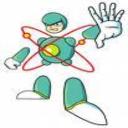Yahoo Answers is shutting down on May 4th, 2021 (Eastern Time) and beginning April 20th, 2021 (Eastern Time) the Yahoo Answers website will be in read-only mode. There will be no changes to other Yahoo properties or services, or your Yahoo account. You can find more information about the Yahoo Answers shutdown and how to download your data on this help page.
Trending News
Physics pulley question?
A mass of 8kg is resting on a horizontal table with a coefficient of kinetic friction of 0.35. the mass..?
is connected to a cable that passes over a pulley of mass 3.5 kg and radius 21cm. the other end of the table is attached to a second hanging mass of 15kg. the system is released from rest.
a) Calculated the acceleration of the system
b) How many times does the pulley rotate in 2 seconds?
Unsure how to apply angular equations to this problem.
2 Answers
- oubaasLv 77 years agoFavorite Answer
let's start from analyzing how translating masses can be transferred to a rotating system and vice versa :
according to energy equivalence (mV^2 = Jω^2) and reminding you that :
- J = 1/2mr^2
- V = ω*r
we get :
mt*V^2 = 1/2*m*r^2*V^2/r^2 = 1/2mV^2
mt = m/2
this latest equation tells us that that if we want to convert translating masses mt into rotating masses m we have to multiply the translating masses by 2 ; if, vice versa, we want to convert rotating masses m into translating masses mt we have to divide the rotating masses by 2
a) solve first the problem translationally assuming g = 10 m/sec^2
me = 3.5/2 = 1.75 kg ( pulley mass transferred to translational sistem)
total system mass M = mt1+mt2+me = 8+15+1.75 = 24.75 kg
motive force Fm = mt2*g = 15*10 = 150.0 N
friction force Ff = mt1*g*μ = 8*10*0.35 = 28.0 N
accelerating force Fa = Fm-Ff = 150-28 = 122 N
acceleration a = Fa/M = 122/24.75 = 4.929 m/sec^2
space h = 1/2*a*t^2 = 4.929*4/2 = 9.86 m
n = h/C = 9.86/(6.28*0.21) = 7.48 revol.
b) let's, now, solve the problem rotationally assuming g = 10 m/sec^2
me1 = 8*2 = 16.0 kg
me2 = 15*2 = 30.0 kg
m = 3.5 kg
total mass M' = me1+me2+m = 3.5+16.0+30.0 = 49.5 kg
total inertia J = 1/2M'*r^2 = 49.5*0.21^2/2 = 1.0915 kgm^2
accelerating torque Ta = (Fm-Ff)*r = g*(mt2-mt1*μ)*r = 10*(15-8*0.35)*0.21 = 25.62 Nm
ώ = dω/dt = Ta/J = 25.62/1.0915 = 23,47rad/sec^2
Θ = 1/2*ώ*t^2 = 23.47*4/2 = 46.94 rad
n = Θ/2PI = 46.94/6.28 = 7.48 revol.
Same final result, as you can see !!! select the one you prefer...
- electron1Lv 77 years ago
There are two forces which affect the acceleration of the system. The weight of the hanging object is causing the acceleration. The friction force is causing the deceleration.
Weight = 15 * 9.8 = 147 N
147 – T1 = 15 * a
T1 = 147 – 15 * a
Ff = 0.35 * 8 * 9.8 = 27.44 N
T2 – 27.44 = 8 * a
T2 = 27.44 + 8 * a
Eq#1: T1 – T2 = 119.56 – 23 * a
Let’s determine the torque. The torque is caused by the two tension forces.
Net torque = T1 * r – T2 * r = (T1 – T2) * r
Torque = I * α
I = ½ * m * r^2
Since we need to determine the acceleration of the system, let’s convert α to a by dividing by r.
Torque = ½ * m * r^2 * a/r = ½ * m * a * r
(T1 – T2) * r = ½ * m * a * r
T1 – T2 = ½ * m * a
Eq#2: T1 – T2 = 1.75 * a
Set Eq#1 equal to Eq#2 and solve for.
119.56 – 23 * a = 1.75 * a
24.75 * a = 119.56
a = 119.56 ÷ 24.75
This is approximately 4.8307 m/s^2.
Let me show you a much easier way to determine the acceleration. Use the following equation.
Net force = Total relative mass * acceleration
For the 15 kg and 8 kg objects, the relative mass is the same as their mass. For a solid cylinder, the relative mass is one half of its mass.
Total relative mass = 15 + 8 * 1.5 = 24.75 kg
Net force = 147 – 27.44 = 119.6
a = 119.56 ÷ 24.75
This is the same answer.
Each time the pulley rotates, a point on the outer edge of the pulley moves a distance that is equal to the circumference of the pulley.
C = 2 * π * 0.21 = 0.42 * π
To determine the distance, use the following equation.
d = vi * t + ½ * a * t^2, vi = 0
d = ½ * 119.56 ÷ 24.75 * 2^2 = 9.661414141 meters
To determine the number of times the pulley rotates in 2 seconds, divide this distance by the circumference of the pulley.
N = 9.661414141÷ 0.42 * π = 7.322199133 times
The answer is approximately 7.32 times





